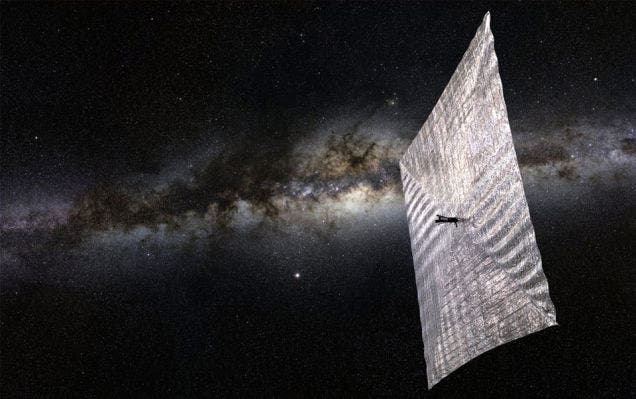In 1976, Carl Sagan went on the Tonight Show with Johnny Carson along with a strange contraption, that looked like a tinfoil square. In all likelihood it was probably tin foil, since it was only a model for what Sagan termed as a solar sail – a simple, but effective spacecraft that harnesses the solar winds to generate power, much like a sail uses the wind to move a ship here on Earth. On May 20th, a tiny satellite the size of a loaf of bread will be blasted into Earth’s orbit from an Atlas V rocket that will test Sagan’s design.

Called LightSail, the project is ran by the Planetary Society, a non-profit organization founded by Sagan himself and now coordinated by Bill Nye. In orbit, LightSail will not only measure solar particles, but also deploy the sail and test the actual mechanism. Hopefully, everything should run smoothly this time, considering a similar attempt was made ten years ago. The first version however never made into orbit since the Russian craft it used to piggyback failed and crashed.
The LightSail is extremely simply designed and looks very much like a kite. The sail is made out of thin Mylar and when stretched out measures 345 square feet.
Nearly 400 years ago, when much of the world thought reaching North America was a pretty solid achievement, Johannes Kepler proposed the idea of exploring the galaxy using sails. The great astronomer thought the tails of the comets he was observing were actually blown away by some kind of solar breeze, so naturally this sort of idea of using a solar sail came to mind. This is obviously false, since there’s no wind in space, but we do know that sunlight can exert enough pressure to move objects.
NASA researchers have found that at 1 astronomical unit (AU), which is the distance from the sun to Earth, equal to 93 million miles (150 million km), sunlight can produce about 1.4 kilowatts (kw) of power. If you take 1.4 kw and divide it by the speed of light, you would find that the force exerted by the sun is about 9 newtons (N)/square mile (i.e., 2 lb/km2 or .78 lb/mi2). In comparison, a space shuttle main engine can produce 1.67 million N of force during liftoff and 2.1 million N of thrust in a vacuum. So… that doesn’t seem like much. However, the solar pressure exerts a continuous acceleration and the longer the sail travels the faster it will become. Eventually, it could reach speeds five times faster than the fastest rockets available today. Because it doesn’t need any fuel, a light powered spacecraft could travel to distant planets and beam back valuable information.
NASA and JAXA have already successfully tested solar sail technology, but with the Planetary Society’s latest efforts solar sails might actually come back into interest. If the LightSail demonstrates solar particle powered propulsion is feasible, then maybe NASA and the European Space Agency (ESA) would finally commit serious money for solar sail research and space missions.






